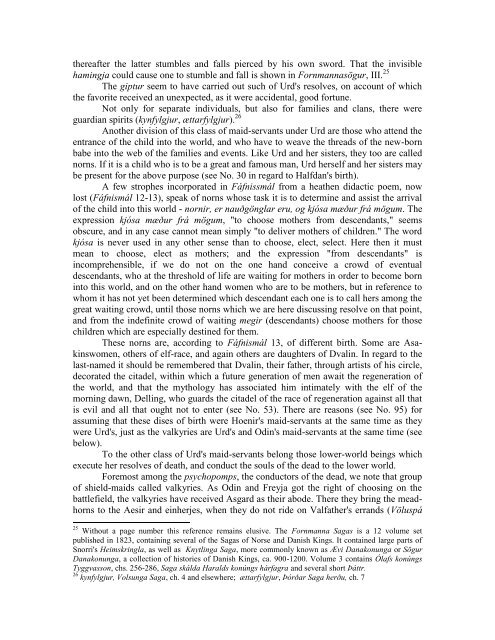Chapters 44-95 - Germanic Mythology
Chapters 44-95 - Germanic Mythology
Chapters 44-95 - Germanic Mythology
You also want an ePaper? Increase the reach of your titles
YUMPU automatically turns print PDFs into web optimized ePapers that Google loves.
thereafter the latter stumbles and falls pierced by his own sword. That the invisible<br />
hamingja could cause one to stumble and fall is shown in Fornmannasögur, III. 25<br />
The giptur seem to have carried out such of Urd's resolves, on account of which<br />
the favorite received an unexpected, as it were accidental, good fortune.<br />
Not only for separate individuals, but also for families and clans, there were<br />
guardian spirits (kynfylgjur, ættarfylgjur). 26<br />
Another division of this class of maid-servants under Urd are those who attend the<br />
entrance of the child into the world, and who have to weave the threads of the new-born<br />
babe into the web of the families and events. Like Urd and her sisters, they too are called<br />
norns. If it is a child who is to be a great and famous man, Urd herself and her sisters may<br />
be present for the above purpose (see No. 30 in regard to Halfdan's birth).<br />
A few strophes incorporated in Fáfnissmál from a heathen didactic poem, now<br />
lost (Fáfnismál 12-13), speak of norns whose task it is to determine and assist the arrival<br />
of the child into this world - nornir, er nauðgönglar eru, og kjósa mæður frá mögum. The<br />
expression kjósa mæður frá mögum, "to choose mothers from descendants," seems<br />
obscure, and in any case cannot mean simply "to deliver mothers of children." The word<br />
kjósa is never used in any other sense than to choose, elect, select. Here then it must<br />
mean to choose, elect as mothers; and the expression "from descendants" is<br />
incomprehensible, if we do not on the one hand conceive a crowd of eventual<br />
descendants, who at the threshold of life are waiting for mothers in order to become born<br />
into this world, and on the other hand women who are to be mothers, but in reference to<br />
whom it has not yet been determined which descendant each one is to call hers among the<br />
great waiting crowd, until those norns which we are here discussing resolve on that point,<br />
and from the indefinite crowd of waiting megir (descendants) choose mothers for those<br />
children which are especially destined for them.<br />
These norns are, according to Fáfnismál 13, of different birth. Some are Asakinswomen,<br />
others of elf-race, and again others are daughters of Dvalin. In regard to the<br />
last-named it should be remembered that Dvalin, their father, through artists of his circle,<br />
decorated the citadel, within which a future generation of men await the regeneration of<br />
the world, and that the mythology has associated him intimately with the elf of the<br />
morning dawn, Delling, who guards the citadel of the race of regeneration against all that<br />
is evil and all that ought not to enter (see No. 53). There are reasons (see No. <strong>95</strong>) for<br />
assuming that these dises of birth were Hoenir's maid-servants at the same time as they<br />
were Urd's, just as the valkyries are Urd's and Odin's maid-servants at the same time (see<br />
below).<br />
To the other class of Urd's maid-servants belong those lower-world beings which<br />
execute her resolves of death, and conduct the souls of the dead to the lower world.<br />
Foremost among the psychopomps, the conductors of the dead, we note that group<br />
of shield-maids called valkyries. As Odin and Freyja got the right of choosing on the<br />
battlefield, the valkyries have received Asgard as their abode. There they bring the meadhorns<br />
to the Aesir and einherjes, when they do not ride on Valfather's errands (Völuspá<br />
25 Without a page number this reference remains elusive. The Fornmanna Sagas is a 12 volume set<br />
published in 1823, containing several of the Sagas of Norse and Danish Kings. It contained large parts of<br />
Snorri's Heimskringla, as well as Knytlinga Saga, more commonly known as Ævi Danakonunga or Sögur<br />
Danakonunga, a collection of histories of Danish Kings, ca. 900-1200. Volume 3 contains Ólafs konúngs<br />
Tyggvasson, chs. 256-286, Saga skálda Haralds konúngs hárfagra and several short Þáttr.<br />
26 kynfylgjur, Volsunga Saga, ch. 4 and elsewhere; ættarfylgjur, Þórðar Saga herðu, ch. 7
















